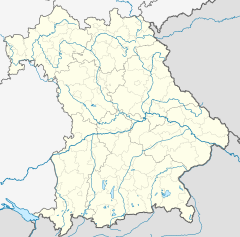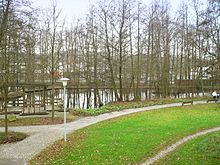
Alfred was the sovereign duke of Saxe-Coburg and Gotha from 1893 to 1900. He was the second son and fourth child of Queen Victoria and Prince Albert. He was known as the Duke of Edinburgh from 1866 until he succeeded his paternal uncle Ernest II as the reigning Duke of Saxe-Coburg and Gotha in the German Empire.

Saxe-Coburg and Gotha, or Saxe-Coburg-Gotha, was an Ernestine, Thuringian duchy ruled by a branch of the House of Wettin, consisting of territories in the present-day states of Thuringia and Bavaria in Germany. It lasted from 1826 to 1918. In November 1918, Charles Edward, Duke of Saxe-Coburg and Gotha, was forced to abdicate. In 1920, the northern part of the duchy was merged with six other Thuringian free states to form the Free State of Thuringia: Saxe-Weimar-Eisenach, Saxe-Altenburg and Saxe-Meiningen, Schwarzburg-Rudolstadt and Schwarzburg-Sondershausen, as well as the People's State of Reuss. The southern part of the duchy, as southernmost of the Thuringian states, was the only one which, after a referendum, became part of the Free State of Bavaria.

Charles Edward, Duke of Saxe-Coburg and Gotha was the last sovereign duke of Saxe-Coburg and Gotha, from 30 July 1900 until 1918. A male-line grandson of Queen Victoria and Prince Albert, he was also until 1919 a Prince of the United Kingdom and from birth held the British titles of Duke of Albany, Earl of Clarence and Baron Arklow.
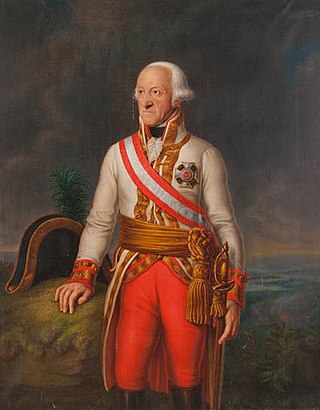
Prince Frederick Josias of Saxe-Coburg-Saalfeld was an Austrian nobleman and military general.
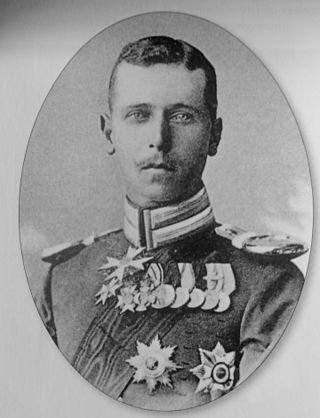
Alfred, Hereditary Prince of Saxe-Coburg and Gotha, KG, KStJ, was the son and heir apparent of Alfred, Duke of Saxe-Coburg and Gotha. He died aged 24 under circumstances still not entirely clear. He was a first cousin of Kaiser Wilhelm II of Germany, King George V of the United Kingdom and Tsar Nicholas II of Russia.

Coburg is a town located on the Itz river in the Upper Franconia region of Bavaria, Germany. Long part of one of the Thuringian states of the Wettin line, it joined Bavaria by popular vote only in 1920. Until the revolution of 1918, it was one of the capitals of the Duchy of Saxe-Coburg and Gotha and the Duchy of Saxe-Coburg-Saalfeld. Through successful dynastic policies, the ruling princely family married into several of the royal families of Europe, most notably in the person of Prince Albert, who married Queen Victoria in 1840. As a result of these close links with the royal houses of Europe in the late 19th and early 20th centuries, Coburg was frequently visited by the crowned heads of Europe and their families.

Reinhardsbrunn in Friedrichroda near Gotha, in the German state of Thuringia, is the site of a formerly prominent Benedictine abbey, the house monastery of the Ludovingian Landgraves of Thuringia abbey extant between 1085 and 1525. Later used as an administrative seat by the Ernestine dukes of Saxony, the property was turned into a castle and park erected by the Dukes of Saxe-Coburg and Gotha from 1827.

Princess Victoria Adelaide of Schleswig-Holstein-Sonderburg-Glücksburg was Duchess of Saxe-Coburg and Gotha as the consort of Duke Charles Edward from their marriage on 11 October 1905 until his abdication on 14 November 1918. Victoria Adelaide is the maternal grandmother of Carl XVI Gustaf of Sweden. She was a niece of German Empress Augusta Victoria.

John Casimir of Saxe-Coburg was the Duke of Saxe-Coburg. He was the descendant of the Ernestine branch of the House of Wettin. Under his rule, the residence town of Coburg prospered with many Renaissance buildings being erected that still remain today.

Princess Dorothea Maria Henriette Auguste Louise of Saxe-Coburg and Gotha was a princess of Saxe-Coburg and Gotha by birth and the duchess of Schleswig-Holstein through her marriage to Ernst Gunther, duke of Schleswig-Holstein. Dorothea was born in Vienna, Austria, the second child and only daughter of Prince Philipp of Saxe-Coburg and Gotha and Princess Louise of Belgium.

Marie of Württemberg was a daughter of Duke Alexander of Württemberg and Antoinette of Saxe-Coburg-Saalfeld. She was Duchess of Saxe-Coburg and Gotha from 1832 to 1844 as the second wife of Duke Ernest I. As such, she was the stepmother of Prince Albert, consort of Queen Victoria.
Hubertus Prinz von Sachsen-Coburg und Gotha is the eldest son of Ernst-Leopold Prinz von Sachsen-Coburg und Gotha and his first wife, Ingeborg Henig.

Schloss Rosenau, called in English The Rosenau or Rosenau Palace, is a former castle, converted into a ducal country house, near the town of Rödental, formerly in Saxe-Coburg, now lying in Bavaria, Germany.
Events in the year 1887 in Germany.
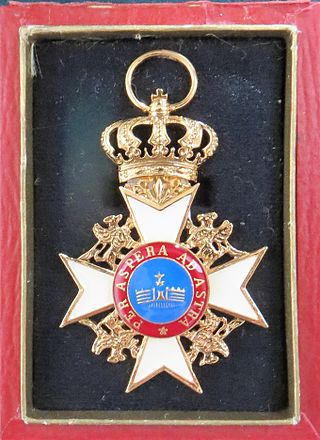
The House Order of the Wendish Crown was an Order of the House of Mecklenburg, jointly instituted on 12 May 1864 by Grand Duke Friedrich Franz II of Mecklenburg-Schwerin and Grand Duke Friedrich Wilhelm of Mecklenburg-Strelitz.
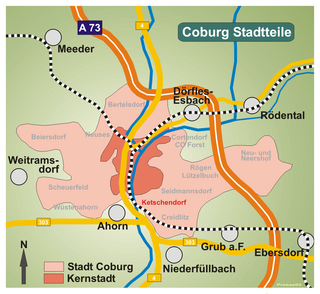
Ketschendorf is a southern suburb of the city of Coburg in the county of Upper Franconia, in the state of Bavaria in Germany.

Callenberg Castle is a castle on a wooded hill in Beiersdorf, an Ortsteil of Coburg, 6 kilometres (3.7 mi) from the town centre. It was a hunting lodge and summer residence and has long been the principal residence of the House of Saxe-Coburg and Gotha. It is currently owned by Andreas, Prince of Saxe-Coburg and Gotha who created the Ducal Saxe-Coburg and Gotha House Order. A large and architecturally important family chapel is contained within.

Heldburg Fortress is a high medieval hilltop castle. In the 16th century it was rebuilt into a renaissance castle. It rises on a former volcanic region to 'Heldburger Gangschar' counted, 405-metre-high volcanic cone, 113 metres above the town of Heldburg in the Heldburger Land, the southern tip of the district Hildburghausen in Thuringia. The Veste Heldburg, once a secondary residence and hunting lodge of the Dukes of Coburg, dominates the little town of Heldburg on the Thuringian border with Bavaria. From it can be seen across the Thuringian border the sister-castle Veste Coburg,, once the residence of the Dukes of Coburg, now located in Bavaria.

Friedenstein Palace is an early Baroque palace built in the mid-17th century by Ernest I, Duke of Saxe-Gotha at Gotha, Thuringia, Germany. In Germany, Friedenstein was one of the largest palaces of its time and one of the first Baroque palaces ever built. Friedenstein served as the main seat of the Dukes of Saxe-Gotha and later as one of the residences of the Dukes of Saxe-Coburg and Gotha, closely linked with the Royal Family of Great Britain through the marriage of Queen Victoria and Prince Albert. The final two ruling Dukes were both princes of the United Kingdom.
Kelly Jeanne, Hereditary Princess of Saxe-Coburg and Gotha, Duchess of Saxony is an American investment banker. Through her marriage to Hubertus, Hereditary Prince of Saxe-Coburg and Gotha, the heir apparent to the defunct ducal throne of Saxe-Coburg and Gotha, she is a princess of the House of Saxe-Coburg and Gotha.

